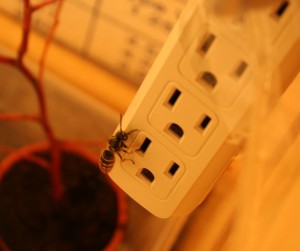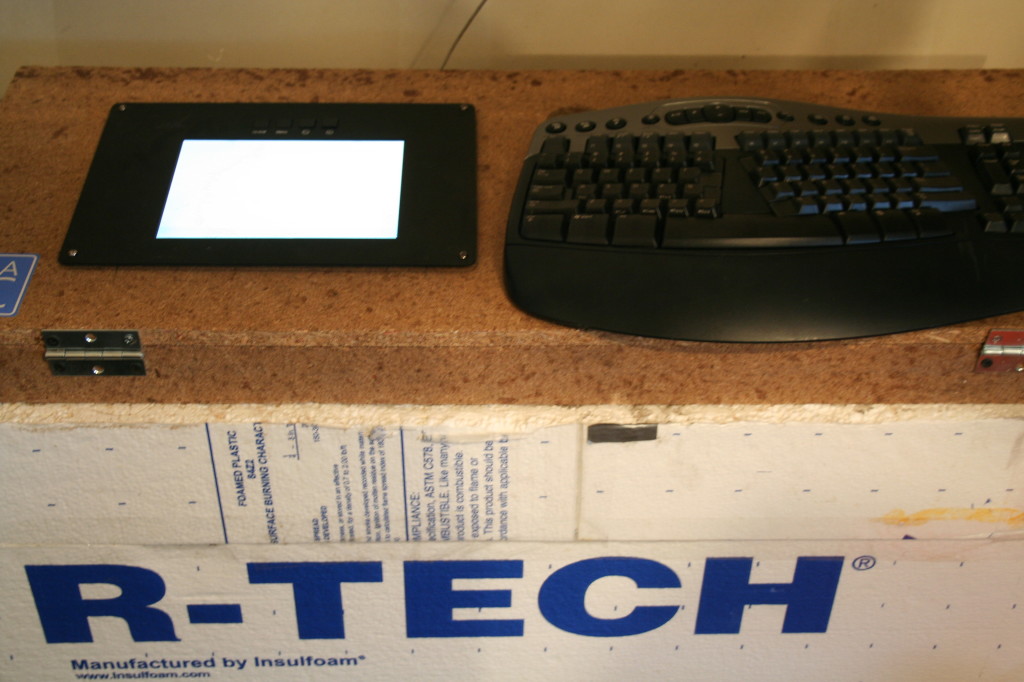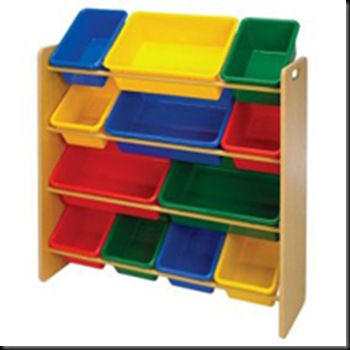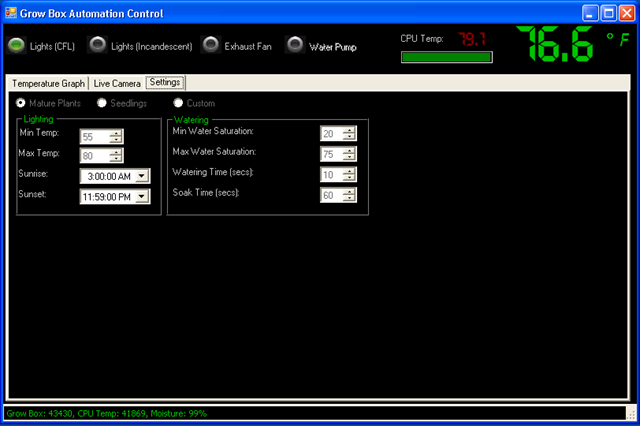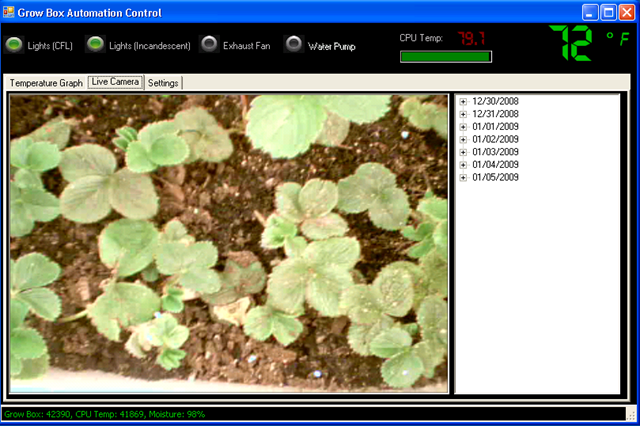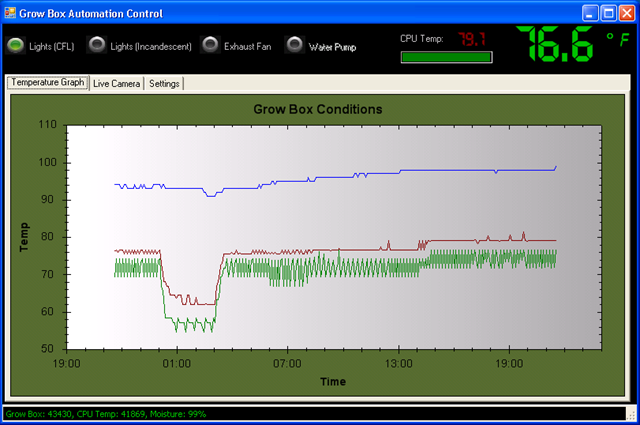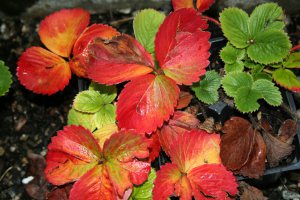A little help in the computerized grow box
15.3 years ago indoor growbox, strawberries
My wife was the first to identify the little helper and today I was able to capture him on camera. Looks like it is more than just the breeze helping pollinate those strawberries in the automated computerized grow box. Yet another benefit of having my grow box in my garage.
Tags: cheap, growbox, strawberry plants, vegetables
Computer controlled grow box – Part 1
15.4 years ago cheap, computer, electronics, indoor growbox, PC thermometer
The Idea and Design
My PC Grow box was very effective though it did have some shortcomings along with my desire for tinkering caused me to create a new version code named “Project Everbearing” after the test subjects for the project, several Everbearing strawberry plants I propagated from my garden last Summer/Fall. The specific shortcomings I wanted to overcome were temperature control and limited size. My grow box has to live in my garage so on cold nights the temperatures can fall low enough to kill my summer seedlings (tomatoes/cucumbers) Size is an easy fix just make it bigger though it is more difficult to keep a larger grow box warm and still well lit.�
My solution to both of these problems was the addition of a computer to the system. First computers generate heat, using this along with computer controlled fans and incandescent lights (heater) allow me to regulate the heat to my desired levels. This is the point a normal person may have just stopped, but I am far from normal and decided a few more features, which I will explain more below.
The Structure and Insulation
First comes the structure, upon inheriting a set of shelves from my sister, we ran out of room for some of our existing storage shelves (see above), though we used the buckets to store loose toys on our new shelves we had the structure of the old one sitting in the garage for some time. After many passes by in the garage not knowing what do do with this shell, it finally came to me that this would be perfect for my new grow box, (Reduce/Reuse/Recycle) in action. The only customization required was the removal of a couple of the wooden dowels and I was ready to add some hardware. Of course you could do the same thing with an old bookshelf, cabinet or just with construct your own frame with a 12”X1”X8’ foot board cut in two along with two 1”X1”X8’ pieces of lumber cut into two. Screw one 1”X1” in each corner and should should have a pretty solid frame. For the top I used pegboard mainly because I bought a 4’ by 8’ sheet when I only needed half of it but worked really good to use zip-ties to secure various components and provides decent airflow between the computer and growing areas.
Second comes insulation, after some not so careful calculations and measurements I determined I could cover the 3 exposed areas with 2 sheets of 2’ by 4’ sheets of insulating Styrofoam. I glued and taped (duct tape of course) the Styrofoam which was cut using a utility knife and straightedge to cut to size making sure I made the top straight and flush. I then created an exactly copy of the other side and one more piece for the top. Using a long strip of duct tape I created a hinge for the top and glued side of the box. The last piece I simply fit into place using a tool box to ensure a tight fit but also allows easy access to plants when needed.
The Lighting
I went cheap on the lighting taking from the success of the PC grow box I decided to go with a similar setup using $2.00 home depot wired sockets hooked up to an couple old computer power cords. I went with two 24 watt CFL bulbs and one incandescent bulb. Though the incandescent is not as efficient and the CLFs it does provide a full spectrum of light and a little extra heat which the box can use in the many times cold garage where it lives. The CFLs and incandescent exist on two separate circuits so they can be controlled independently by the software.
The Software — Grow box brains
Now I know all of this could be done with a Basic Stamp or Arduino pretty easy, but I wanted the ability to track history and have a decent user interface to look at, so I wrote a windows form application using C#. To cover the basic functionality of temperature control I used the parallel port outputs hooked up to the computer’s parallel port to give the software the ability to turn the lights on and off. By configuring a “sunset” and “sunrise” time which I am in complete control over the lights will turn on and off as appropriate. I added some logic to ensure the plants stay at a comfortable temperature (thresholds configurable) by turning on the incandescent bulb when it is too cold and an exhaust fan when it gets too hot. In order to allow the computer to know these temperatures I used a PS2 controller to create two temperature sensors one for the area the plants are growing and another for the top area where the CPU resides (computer was too old to have onboard temperature sensor)
My daughter thought it would be cool if we have some sort of automatic watering system. I agreed, so I added a moisture sensor and created an algorithm to periodically check the moisture level and activate a water pump to add water until it reaches the specified moisture level. I still need to buy and hookup the pump but coding portion is complete and tested.
I live in the Pacific Northwest it rains a lot and can get cold in the evenings and I don’t want to trek out to check on my plants. solved this by adding the computer to my Wi-Fi network now I can take look at them by connecting to the machine wirelessly and see how they are doing through it’s webcam. I also take periodic pictures of the plants so I can create cool time-lapse videos of progress like the one below. I also have the ability to browse through pictures taken at specific time periods.
Finally to store all of this data I installed SQL Server 2005 Express (free) which allows me to track historical data of the conditions and images over time. If you have data, you definitely need some graphs. Being too lazy to do this graphic work I leveraged ZedGraph (free) to allow some visual tracking of temperatures and moisture content.
Features for future versions (Beta 2?)
- Finish automated watering
- Add automated red LED lights for flowering stage
- Install LCD Panel
- Make box look better (real door which does not require tape to open/close)
- Create single USB controller for lights/sensors
- Better/additional camera
Video of grow box “booting” up, personally I like the flashing lights when the computer sends signal through the parrallel port. If you are old enough to ever have a printer that used a parallel port this is when it would make its annoying sound letting you know it was alive.
Updates:
Computerized Grow Box Update #1
Tags: arduino, cheap, garden seeds, grow lights, growbox, led, outdoor plants, strawberry plants, tomato plants, vegetables
Fall Strawberries
15.5 years ago strawberries
I really like the color of these strawberries I propagated last this summer. I still have to figure out what I am actually going to do with these.
Tags: cheap, outdoor plants, strawberry plants, vegetables
Propagation of strawberry plants
15.8 years ago strawberries
My strawberries have stopped producing berries and now have started send runners all over the place. During the berry growing season I would pinch them off to let the plants use their energy creating delicious berries. Now those runners are not really doing any harm I have decided to let some of them live and propagate them into some small plant trays.
I grow my strawberries in the open end of cinder blocks and the rest of my vegetable garden is surrounded by gravel so not really any place for them to go, with the exception of taking over my vegetable garden. Given they will not grow in gravel and I like vegetables in my vegetable garden I have redirected them into some plant trays (ironically the same ones I brought the plants parents home in) filled with potting mix. All you do is simply put the end of the runner in the soil and it will do the rest. To keep the runner from popping out of the soil, the normal convention is to create a U-shape with a paperclip to hold the runner in place underground, for whatever strange reason I couldn’t find any of these anywhere in my house I opted for bent bamboo skewers. After about a week you should have your very own baby strawberry plants at this time you can cut the “umbilical” cord from the mother plant. Now the next question is where I am going to put these new plants…guess I need to make a new garden bed or find some friends that want some strawberries next year.
Tags: led, outdoor plants, strawberry plants, vegetables
Strawberries in the garden
15.9 years ago indoor growbox, strawberries
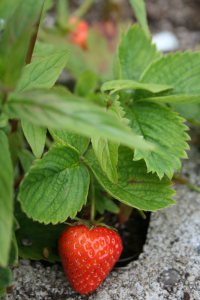
Strawberries thrive here in the Pacific Northwest but this year the June bearers almost missed their month this year with some of the erratic weather we have had during the past couple months. Last year I planted about a half dozen June bearing plants in the holes of the cinder blocks that surround my raised bed. We got enough strawberries to keep our oldest daughter satisfied for an occasional snack but still had to supplement from the grocery store to satisfy her strawberry habit and with the rising produce prices I let the let some of the runners spread to their neighboring cinder block holes and some cases transplanting the start to a more appropriate location. A couple months ago I also planted some different varieties of Everbearing strawberries to provide fruit throughout more of the summer.
The normal life cycle of a strawberry plant is 3 years. The first year will consist of plant growth where you should see a decent number of strawberries but not as much as the second year. My second year plants are about a foot tall and have dozens of large strawberries growing on them. I have been cutting any runners that shoot out to allow the plant to spend its energy on those delicious berries. The third year the plant’s production will be less and will be spending more of its energy on its runners which is a good time to let those runners turn into new plants and let the cycle repeat. After the plants have finished producing this is the time to fertilize with a balanced fertilizer (10-10-10) otherwise this can lead to excessive leaf growth and less production. Fertilizing at this time will also give the plants the chance to store some much needed energy over the cold winter and have a good head start for the following spring.
Now this morning my oldest daughter was tired of picking strawberries sure it had nothing to do with her picking two and a half pounds of strawberries at Harvold Berry Farm the day before.
Tags: cheap, outdoor plants, strawberry plants, vegetables
Planning a butterfly garden
16.2 years ago butterfly garden, kids
I got the word this weekend we had enough vegetables and not enough flowers in our garden beds so got the idea to start a butterfly garden. Upon telling my 6 year old daughter she got very excited and started talking how we can charge admission for people to see our butterfly garden.
There are two ways to get butterflies in your gardens, provide nectar to eat and/or give them a great environment to lay their eggs. If you remember your grade school science classes those eggs turn into caterpillars which depending on what else you have in your vegetable garden this might not be exactly the pest you want to encourage to inhabit your garden. If that is your situation I would recommend only planting the nectar attracters. After carefully investigating what caterpillars eat by reading The Very Hungry Caterpillar from cover to cover I decided my risk should be minimal if we have our butterfly garden on the other side of our yard away from our strawberries.
To attempt to get the butterflies to lay eggs, we bought Snapdragons and Daisies. To provide butterflies with tasty nectar we picked out Black-eyed Susan, purple coneflowers, zinnias, and nasturtiums, Lavender, Daisies (as well), and Mint. We are also planning on creating a butterfly feeder by taking a small jar and drilling a hole in the top. Put some cotton snuggly in the hole and fill with solution of 1 part sugar to 9 parts water and cheap butterfly (or hummingbird) feeder is ready for visitors.
Will keep posted with progress on the butterfly garden and I anticipate the butterfly feeder will have plenty of “decorating” involved. If you want something that might look a little more attractive in your garden you might want to take a look at the commercial butterfly feeders.
Read Other Butterfly Garden Posts
Tags: butterfly garden, cheap, outdoor plants, strawberry plants, vegetables
